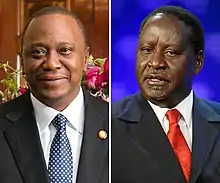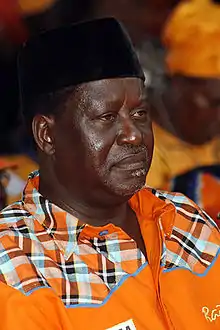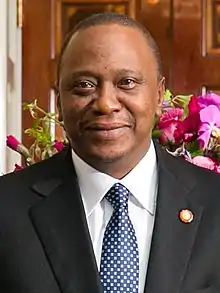2018 Kenya handshake
.svg.png.webp) |
|---|
| This article is part of a series on the politics and government of Kenya |
|
|
Background information

For long periods of time Kenya has been privy to divisive politics rising from periodical general elections that have been allegedly marred by rigging, and subsequent political motivated violence.[1] Kenya has an extensive record of political violence that has been ethnically mobilized and the exacerbation of militias supported by politicians. Kenya's tribal war did not start yesterday, it goes way back to the times of Jaramogi Oginga Odinga, where parties were formed based on one's tribe. Detrimental effects of the disputed general elections have been witnessed since time immemorial, that is from 1997, when Kenya's ruling party then, Kenya African National Unity (KANU) unleashed terror in order to coerce the citizens and to forge forward their devolution agenda.[2] The Digo Community was mobilized to fight against the peoples of the Western and Central Part of Kenya. This resulted to the displacement of more than 10000 people and the death of 104 innocent civilians.[3] Reports from the judiciary indicated the existence of vigilante groups funded the then ruling party led by Daniel arap Moi. Key among them was Jeshi La Mzee. There was a resurgence of conflict between the Kikuyu and the Kalenjin, that existed up until 2013. The party that took over power in 2002, the National Rainbow Coalition led by Mwai Kibaki, ensured that there was peace, not until 2005 when a referendum was held to vote for a newly drafted constitution. People across divided felt that the national coalition was divided into ethnic lines. This saw the Luo led by Raila Odinga break away to form the Orange Democratic Movement.[4] The events that followed would see Kenya sink into a deep economic crisis as a result of the 2007/8 general elections. The Presidential elections were hotly contested between two main opponents Mwai Kibaki and Raila Odinga, however, Odinga disputed the results of the elections that declared Mwai Kibaki as the winner. He insisted that they were marred with mass rigging, theft and inconsistencies in the way they were conducted. This sparked what Kenyans would refer to as exemplifying Kenya as a "a cradle of violence" as the elections plunged Kenya into periods of blood shade and mass killings of innocent Kenyans. Animosity and enmity were at the peak along different ethnic divides. The observers, like the European Union, noted discrepancies in the election result, which ragged fury in people of the Luo Community who were ardent supporters of Raila Odinga a.k.a Baba.[5] This period saw vigilante groups like Mungiki, American Maine, China Group clashing and terrorizing innocent civilians. More than 650000 were displaced as a result and around 1300 people lost their lives making this post-election skirmish to be the single most detrimental in Kenyan history.[6] The International Criminal Court then instituted charges of crime and inciting of violence on six Kenyans, widely referred to as the "Ocampo Six", among them Uhuru Kenyatta and the incumbent deputy president of Kenya William Ruto. The preceding elections did not proof different, the general elections in Kenya in 2013 were bitterly contested by two rivals Uhuru Kenyatta of The National Unity and Raila Odinga of the Coalition of Reforms and Democracy. Uhuru was declared the winner, which Raila disputed due to the involvement of the Bio-metric Voter System, which he highlighted its drawbacks. CORD was calling for reforms in the conduct of elections to be free and fair and hence challenged Uhuru's election in the Supreme Court, which later upheld Uhuru's election.[7] 2017 saw the same contestants face each other in an election that was widely presumed to have already been predetermined since the electoral systems were hacked. The Chief Technological Officer at the independent and boundaries electoral commission IEBC, Chris Msando, was murdered in cold blood, in a plot that seemed an assassination.[8] There was a tension rose and therefore the outcome of the election was disputed by the NASA coalition led by Raila Odinga and Lawyers like Miguna Miguna since they felt the electoral commission's systems were compromised and hacked.[9] The NASA Coalition proceeded to court to seek for the nullification of the elections, which the supreme court of Kenya led by chief justice declared null and void.[10] A second election held, saw the NASA coalition not participate in them not until their irreducible minimums were met, hence went in favor of Kenyatta who garnered 98% of the vote. This fueled a period of unrest, with Odinga declaring himself as the People's President,[11] leading to warring factions between the supporters of Uhuru and Odinga. This was followed by mass shootings in opposition areas, in the slums and Kisumu.[12]
These events gave rise to the now famous household name "The March 9th Handshake", that brought together two national leaders who put their differences aside to serve Kenyans, Uhuru Kenyatta, and Raila Odinga.

The Handshake
At the wake of 9 March 2018, Kenyans woke to "life-changing" news through a rather unexpected event. News that the key leaders, Raila Odinga, and Uhuru Kenyatta, who were at the helm of the divisive politics and hurling insults at each other were putting their differences aside and uniting through a "Handshake". This was a public declaration to cease all hostilities and instead find a common ground in the interest of moving the country forward economically and politically.[13] After a prolonged period of turmoil, Kenya was now up on its two feet. However, politicians allied to The National Super Alliance (NASA) felt that this was betrayal and that Raila had not consulted. In as much as Kenyans perceived it an act of leaders putting aside their egocentric interests aside, there was an element of betrayal that was brought out by this sudden union.[14] This also sparked the 2022 presidential election, with now Raila joining the government, was Ruto's presidential bid in 2022 thwarted?[15]

Significance of the Handshake
Raila Odinga can now freely visit the backyard of Uhuru Kenyatta, Gatundu while Uhuru Kenyatta could in Kisumu without any animosity from the locals.[16]
Raila Odinga was appointed as Africa Union's High representative for Infrastructural Development, which has been attributed to the renewed good relations between him and Uhuru, that might have made Uhuru tip him for the job[17]
Members of Parliament who had hostility against each other announced an end to the same, that is, Embakasi East Member of Parliament, Babu Owino and Starehe's Charles Njagua.[18]
Activities of ‘National Resistance Movement’ also subsided despite attempts by its self-declared General Miguna Miguna, who was deported to Canada to revamp it.[19]
References
- "In Kenya, politics split on ethnic divide | DW | 26.10.2017". DW.COM. Retrieved 27 March 2019.
- Spencer, Leighann. "Kenya's history of political violence: colonialism, vigilantes and militias". The Conversation. Retrieved 27 March 2019.
- Spencer, Leighann. "Kenya's history of political violence: colonialism, vigilantes and militias". The Conversation. Retrieved 27 March 2019.
- "Raila Odinga - love him or loathe him". 19 October 2017. Retrieved 27 March 2019.
- Gettleman, Jeffrey (31 December 2007). "Disputed Vote Plunges Kenya Into Bloodshed". The New York Times. ISSN 0362-4331. Retrieved 27 March 2019.
- Spencer, Leighann. "Kenya's history of political violence: colonialism, vigilantes and militias". The Conversation. Retrieved 27 March 2019.
- Longwe, Brian Munyao. "Technology, transparency, and the Kenyan general election of 2013". www.aljazeera.com. Retrieved 27 March 2019.
- "Chris Msando died a painful death - Daily Nation". www.nation.co.ke. Retrieved 27 March 2019.
- "Kenya results hacked, opposition says". 9 August 2017. Retrieved 27 March 2019.
- "Court annuls Kenya presidential election". 1 September 2017. Retrieved 27 March 2019.
- "Raila Odinga 'sworn in' as Kenya's people's president". www.aljazeera.com. Retrieved 27 March 2019.
- "Kenyan police accused of rape in opposition strongholds after elections, says HRW | DW | 14.12.2017". DW.COM. Retrieved 27 March 2019.
- Digital, Standard. "Raila Odinga reflects on his March 9, 2018 handshake with Uhuru Kenyatta a year on : SDV". www.standardmedia.co.ke. Retrieved 27 March 2019.
- "With a handshake, Kenya leaves behind divisive poll - Daily Nation". www.nation.co.ke. Retrieved 27 March 2019.
- Otieno, Protus Onyango and Rawlings. "Is Handshake a two-people affair?". The Standard. Retrieved 27 March 2019.
- "The power of a handshake - Daily Nation". www.nation.co.ke. Retrieved 27 March 2019.
- Kondo, Valentine. "2018 Review: Uhuru, Raila's handshake on Kenyan economy". The Standard. Retrieved 27 March 2019.
- "The power of a handshake - Daily Nation". www.nation.co.ke. Retrieved 27 March 2019.
- "Miguna Miguna deported, again - Daily Nation". www.nation.co.ke. Retrieved 27 March 2019.

